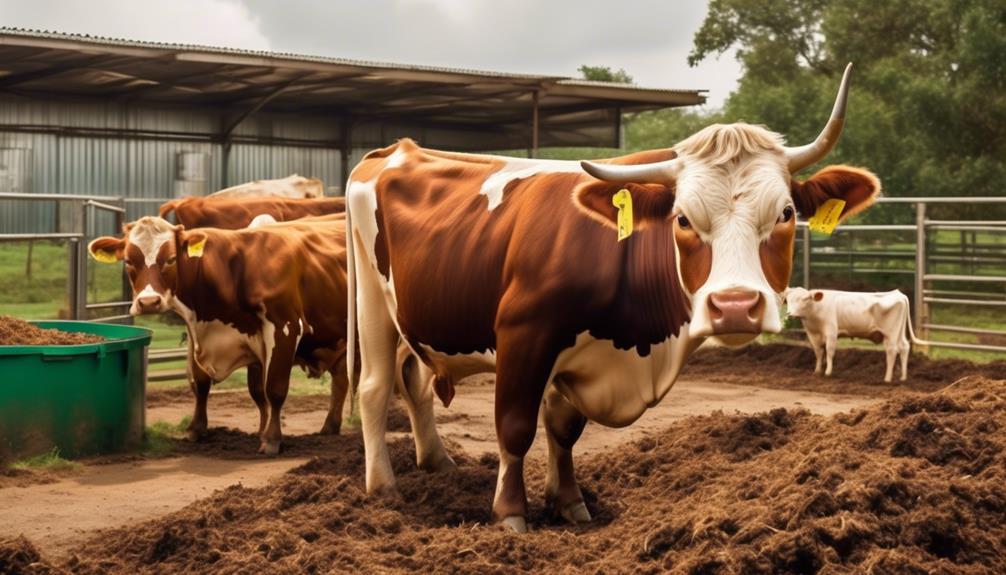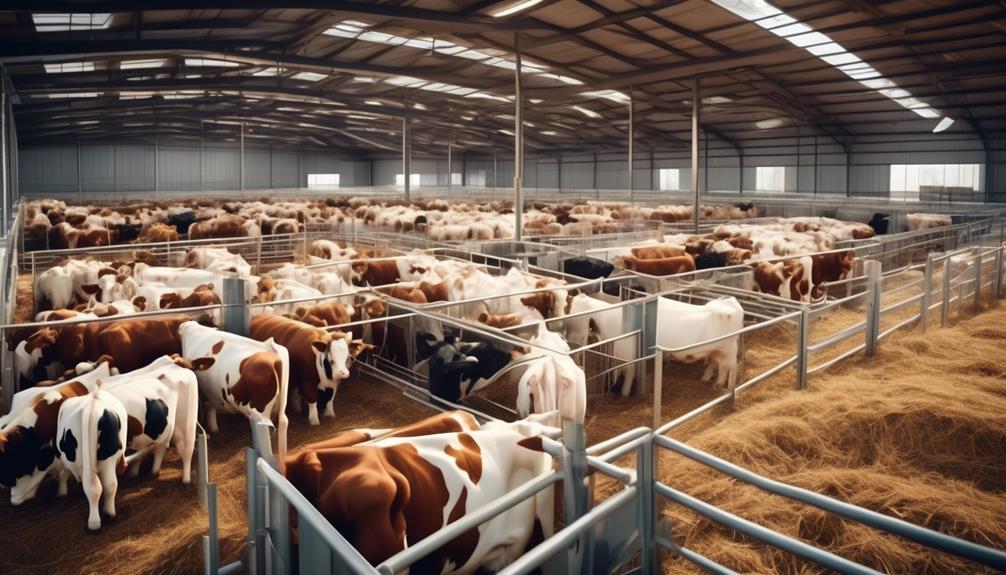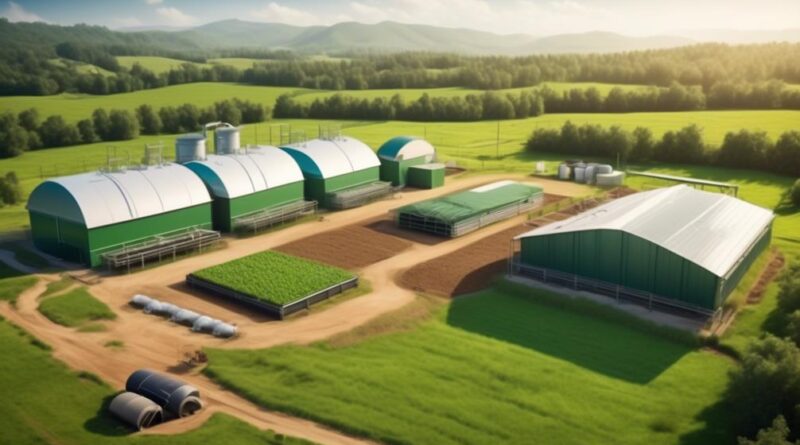Maximizing Sustainability in Cattle Waste Management
Imagine a sprawling cattle ranch with vast fields and grazing cows under the open sky. Now, consider the inevitable byproduct of such a scene: cattle waste.
As a cattle rancher or someone involved in the livestock industry, you understand the challenges and complexities of managing this waste in a sustainable manner. It's not just about the environmental impact, but also about maximizing the potential benefits and minimizing the drawbacks.
In this discussion, you'll explore innovative techniques and best practices that can revolutionize the way cattle waste is managed, offering both environmental and economic advantages that you may not have considered before.
Sustainable Cattle Waste Management Techniques

Implementing sustainable cattle waste management techniques is essential for reducing environmental impact and promoting ecological balance. One key aspect of sustainable cattle waste management is the utilization of renewable energy sources. By incorporating renewable energy technologies such as solar panels or biogas digesters, you can effectively power the waste management processes, reducing reliance on non-renewable energy sources and decreasing the overall carbon footprint of the operation.
Additionally, sustainable cattle waste management techniques aim to contribute to soil enrichment. Instead of allowing waste to become a pollutant, it can be repurposed to enrich the soil. Through composting or anaerobic digestion, the nutrients in the waste can be converted into valuable fertilizer, promoting soil health and reducing the need for chemical fertilizers.
This not only benefits the immediate agricultural area but also helps to prevent water pollution by minimizing the leaching of harmful substances into the groundwater.
Benefits of Proper Waste Disposal
To fully grasp the significance of sustainable cattle waste management, it's crucial to understand the substantial benefits that proper waste disposal can yield for both the environment and agricultural practices. By implementing proper waste disposal methods, such as composting and anaerobic digestion, you can significantly reduce pollution and contribute to environmental conservation efforts.
Proper waste disposal plays a vital role in reducing pollution, particularly water and air pollution. When cattle waste isn't managed effectively, it can leach into water sources, contaminating groundwater and causing algal blooms that harm aquatic ecosystems. Additionally, the release of methane and other greenhouse gases from decomposing waste contributes to air pollution and climate change. However, by implementing sustainable waste management practices, such as capturing methane for energy or converting waste into valuable compost, you can mitigate these environmental impacts.
Furthermore, effective waste disposal contributes to environmental conservation by minimizing the overall ecological footprint of agricultural operations. When waste is properly managed, it can be repurposed as nutrient-rich fertilizer, reducing the need for synthetic fertilizers that can leach into the soil and harm natural habitats. This not only conserves natural resources but also promotes healthier soil and plant growth.
Implementing Composting Systems
Considering the environmental benefits and nutrient-rich results, composting systems play a crucial role in sustainable cattle waste management. Implementing composting systems offers numerous benefits for both the environment and agricultural practices.
Firstly, composting helps in the reduction of greenhouse gas emissions, as it promotes the breakdown of organic matter in an oxygen-rich environment, thus minimizing methane production. Additionally, the resulting compost serves as a valuable soil amendment, enriching the soil with essential nutrients and improving its structure, water retention, and overall health.
The composting process involves gathering cattle waste, such as manure and bedding materials, in designated composting areas. It's essential to create the right mix of carbon-rich (e.g., straw or sawdust) and nitrogen-rich materials (e.g., manure) to foster the decomposition process. Regular turning and aeration of the compost pile are necessary to ensure that oxygen reaches all parts of the mixture, facilitating the growth of aerobic bacteria that break down the organic matter. Monitoring the temperature and moisture levels within the compost pile is crucial for ensuring the efficiency of the composting process.
When the composting process is complete, the resulting material can be used as a natural fertilizer, reducing the reliance on synthetic chemicals and closing the nutrient cycle within the agricultural system.
Implementing composting systems is a sustainable approach to managing cattle waste, providing environmental benefits and nutrient-rich compost for soil enhancement. By integrating composting into waste management practices, you can contribute to both environmental conservation and agricultural productivity.
Utilizing Anaerobic Digestion
You can further enhance your cattle waste management efforts by exploring the utilization of anaerobic digestion as a complementary method to composting systems. Anaerobic digestion involves breaking down organic materials, such as cattle waste, in an oxygen-free environment to produce biogas and nutrient-rich digestate. This method offers several benefits, making it a valuable addition to your sustainability efforts:
- Biogas Production: Through anaerobic digestion, organic materials in cattle waste are converted into biogas, mainly composed of methane and carbon dioxide. This biogas can be utilized as a renewable energy source for heating, electricity generation, or vehicle fuel, contributing to a more sustainable and self-sufficient operation.
- *Energy Independence*: By harnessing biogas from anaerobic digestion, you can reduce reliance on traditional energy sources, thereby mitigating operational costs and environmental impact.
- *Renewable Energy Credits*: The production of biogas through anaerobic digestion may also open up opportunities for earning renewable energy credits, further bolstering the economic viability of your cattle waste management system.
- Methane Reduction: Anaerobic digestion significantly reduces methane emissions, a potent greenhouse gas, compared to traditional manure management methods. By capturing and utilizing methane through anaerobic digestion, you actively contribute to mitigating climate change and demonstrate environmental stewardship within the agricultural sector.
Incorporating anaerobic digestion into your cattle waste management strategy not only maximizes resource efficiency but also aligns with sustainable practices that benefit both your operation and the environment.
Best Practices for Nutrient Management
When managing cattle waste, implementing effective nutrient management practices is essential for optimizing soil health and minimizing environmental impact.
Nutrient management involves carefully controlling the application of cattle waste to maximize its benefits while minimizing potential negative effects. One of the best practices for nutrient management is optimizing nutrient utilization. This involves matching the nutrient content of the waste with the specific needs of the soil and crops.
By understanding the nutrient requirements of the soil and crops, you can ensure that the application of cattle waste provides the necessary nutrients without overloading the soil. This practice not only promotes soil health but also reduces the risk of nutrient runoff into water bodies, thus minimizing environmental impact.
Another important aspect of best practices for nutrient management is soil health. Implementing practices that promote soil health, such as regular soil testing, helps in understanding the nutrient levels and overall health of the soil.
This information can guide the appropriate application of cattle waste to supplement any nutrient deficiencies and maintain the soil's productivity. Additionally, incorporating cattle waste into sustainable agricultural practices, such as crop rotation and cover cropping, can further enhance soil health and overall agricultural sustainability.
Innovations in Waste Treatment Technology
To continue exploring sustainable cattle waste management, let's now focus on the latest innovations in waste treatment technology. Here are some cutting-edge developments that are revolutionizing the way we manage cattle waste:
- Biogas Production: New advancements in waste treatment technology have led to the development of efficient biogas production from cattle waste. This process involves harnessing the methane produced by microbial decomposition of the waste and converting it into biogas, which can then be used as a renewable energy source. This not only helps in waste management but also contributes to sustainable energy production.
- Microbial Processes: Innovations in waste treatment technology have led to the use of advanced microbial processes to break down organic matter in cattle waste. By utilizing specific strains of bacteria and other microorganisms, these processes can effectively degrade organic waste, resulting in reduced environmental impact and the production of valuable byproducts such as organic fertilizers.
- Advanced Treatment Systems: The development of advanced treatment systems, such as anaerobic digesters and biofiltration units, has significantly enhanced the efficiency of cattle waste management. These systems utilize innovative technologies to optimize waste treatment processes, minimize odors, and reduce harmful emissions, thereby promoting environmentally friendly waste management practices.
These innovations represent exciting prospects for the sustainable management of cattle waste, offering environmentally responsible solutions while also presenting opportunities for resource recovery and renewable energy generation. Incorporating these cutting-edge technologies into waste management practices can lead to significant advancements in sustainability and environmental stewardship.
Regulatory Compliance and Environmental Impact

Regulatory compliance with environmental standards is crucial for ensuring responsible cattle waste management practices. Environmental regulations play a pivotal role in shaping the cattle industry's impact on the environment. Compliance with these regulations presents significant challenges, particularly in the management of cattle waste. The industry faces the complex task of meeting strict environmental standards while ensuring sustainable solutions for waste management.
Environmental regulations are designed to mitigate the environmental impact of cattle waste, focusing on aspects such as water and air quality, soil health, and overall ecosystem preservation. Adhering to these regulations necessitates the implementation of efficient waste management practices that minimize negative environmental effects. However, compliance challenges arise due to the sheer volume of waste produced by the cattle industry and the need to handle it in an environmentally responsible manner.
To address compliance challenges and minimize environmental impact, sustainable solutions are imperative. This involves the development and adoption of innovative waste treatment technologies and management practices. Sustainable solutions aim to strike a balance between regulatory compliance and environmental preservation, thereby ensuring that cattle waste management aligns with responsible and sustainable environmental practices.
Economic Viability of Sustainable Waste Management
Ensuring the economic viability of sustainable waste management practices is essential for the long-term success of cattle waste management initiatives. To maximize the economic benefits of sustainable waste management, consider the following:
- Cost Analysis
Conduct a thorough cost analysis to understand the financial implications of different waste management approaches. This should include the initial investment required for infrastructure and technology, ongoing operational costs, and potential savings or revenue streams generated from the waste management process.
- Market Demand
Assess the market demand for sustainable waste management products or by-products. Understanding the market dynamics will help in identifying potential revenue streams or cost-saving opportunities. Additionally, it enables you to align waste management practices with market demands, creating a sustainable and profitable business model.
- Innovative Solutions
Explore innovative solutions and technologies that not only enhance sustainability but also offer economic advantages. This could include the development of value-added products from cattle waste, such as biogas for energy generation or organic fertilizers for agricultural use.
Frequently Asked Questions
What Are the Potential Long-Term Environmental Impacts of Improper Cattle Waste Management?
Improper cattle waste management can lead to long-term environmental impacts, such as ecosystem degradation and reduced environmental sustainability. It's essential to address these issues to ensure the preservation of natural resources for future generations.
How Can Small-Scale Cattle Farmers Implement Sustainable Waste Management Techniques on Their Farms?
To implement sustainable waste management on your small-scale cattle farm, consider biogas production and composting techniques. These methods can help you efficiently manage cattle waste while reducing environmental impact and maximizing resource utilization.
Are There Any Emerging Technologies or Innovations in Cattle Waste Management That Show Promise for the Future?
There are emerging technologies and innovative solutions in cattle waste management that show promise for the future. These advancements can improve sustainability and efficiency in handling and utilizing cattle waste on small-scale farms.
What Are the Social and Community Benefits of Implementing Sustainable Cattle Waste Management Practices?
Implementing sustainable cattle waste management practices can lead to community engagement and economic benefits. It fosters a cleaner environment, reduces health risks, and provides opportunities for renewable energy production, ultimately benefiting the community and local economy.
How Does Climate Change Impact the Effectiveness of Traditional Cattle Waste Management Methods, and What Alternatives Are Being Explored?
Climate change impacts traditional cattle waste management methods, causing environmental harm. Sustainable alternatives, such as anaerobic digestion and composting, are being explored to reduce methane emissions and water pollution, ensuring more effective and eco-friendly waste management.
Conclusion
In conclusion, maximizing sustainability in cattle waste management is crucial for maintaining environmental health and economic viability.
By implementing proper waste disposal techniques, such as composting and anaerobic digestion, and adhering to regulatory compliance, you can effectively reduce the environmental impact of cattle waste.
Additionally, utilizing innovative waste treatment technology and best practices for nutrient management can further enhance the sustainability of cattle waste management.
Overall, prioritizing sustainable waste management is essential for the long-term health of our environment and agricultural industry.
